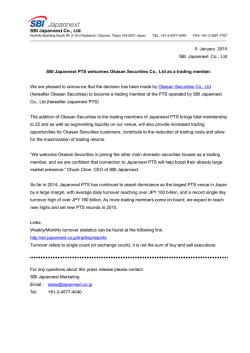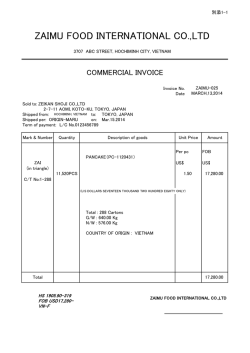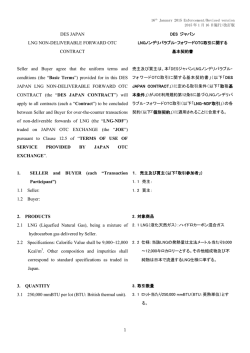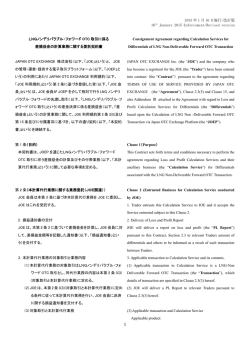
Conflict of Interest Management Policy
October 10th 2014
State Bank of India, Japan
Conflict of Interest Management Policy
1. Purpose
In connection with the diversification of services provided by financial institutions and the
development of global financial conglomeratization, multiple interests compete or conflict with each
other within a financial institution or financial group increasing the possibility of conflicts of interests.
Under such circumstances, State Bank of India, Japan ("Branch") is required to manage the
transactions that may cause conflicts of interests so as to prevent the interests of our customers from
being unjustly impaired.
The Branch, foreign bank under the Banking Act has established the Conflict of Interest Management
Policy (the "Policy"), which is required in the creation of the conflict of interest management system
under applicable laws and regulations.
2. Types of Transactions That May Cause Conflicts of Interests; Process of Identification, Etc.
(1) Covered Transactions
"Transactions that may cause conflicts of interests," which are covered by this Policy, means such
transactions conducted by the Branch, Bank Agency whose principal bank is the Branch or any of its
Parent Financial Institutions, Etc. (as defined in 3 below) or Subsidiary Financial Institutions, Etc. (as
defined in 3 below) that may unjustly impair the interests of our Customers (the "Covered
Transactions").
Conflicts of interests may occur 1) between the Branch, Bank Agency whose principal bank is the
Branch and/or any of its Parent Financial Institutions, Etc. or Subsidiary Financial Institutions, Etc.,
and their Customers, or 2) between the Customers of the Branch, Bank Agency whose principal bank
is the Branch and/or any of its Parent Financial Institutions, Etc. or Subsidiary Financial Institutions,
Etc., and other Customers.
"Customer" means, in relation to the "Banking Related Business" conducted by the Branch, Bank
Agency whose principal bank is the Branch or any of its Subsidiary Financial Institutions, Etc., 1) any
customer who has already established business relations, or 2) any customer who may establish
business relations
"Banking Related Business" means "businesses can be conducted by a bank" and includes core
business of a bank (Banking Act Article 10 Clause 1), ancillary business (Article 10 Clause 2),
Financial Instruments and Exchange Business (Article 11) and other business under provisions of
other laws (Article 12).
(2) Types of Transactions That May Cause Conflicts of Interests; Criteria
The following transactions may be considered as types of "transactions that may cause conflicts of
interests." However, as these types are only criteria to determine whether there is any "transaction that
may cause any conflict of interests," please note that the satisfaction of any such criteria does not
necessarily mean the occurrence of a "transaction that may cause a conflict of interests." Also, please
note that some additions or modifications may be made in the future as may be necessary.
If any Customer reasonably expects that his/her own interests will be prioritized through
counseling or advice (Duty-of-Loyalty Type);
If the Branch or any of its Affiliates may obtain any economic profit or avoid any economic loss
knowing it may impair interest of Customer (Duty-of-Loyalty Type);
If the Branch or any of its Affiliates obtains or will obtain any incentive in the form of money,
goods or services other than the usual commission fees or expenses in connection with the
transactions with any person other than their Customers (Duty-of-Loyalty Type);
If the Branch or any of its Affiliates conducts any transaction with any Customer who should be
protected by the Branch or such Affiliate (Self-Agency Type);
If the Branch or any of its Affiliates conducts any transaction under which the Branch or such
Affiliate takes the side of the counterparty of any Customer who should be protected by the Branch
or such Affiliate (Two-Side Agency Type);
If the Branch or any of its Affiliates conducts any transaction with the counterparty of any
Customer who should be protected by the Branch or such Affiliate, which counterparty competes
with such Customer (Competitive Transaction Type);
If the Branch or any of its Affiliates conducts any transaction through the use of non-public
information on any Customer who should be protected by the Branch or such Affiliate, which
transaction results in any benefit to the Branch or any such Affiliates (Information Use Type); or
If the conditions for similar transactions may not be expected due to the involvement of Branch or
any of its Affiliates in the same transaction on multiple sides (Transaction-Internalization Type).
With regards to the acts prohibited under the Banking Act, or any other laws or regulations that
constitute “transactions that may cause conflicts of interests”, the Branch will “identify” such
transactions in accordance with this Policy, but the “management” of such transactions will be
conducted in accordance with the existing compliance system.
In addition, upon determining whether any conflict of interests has occurred, the Branch will consider
whether any impact upon the reputation of the Branch or the Group has been caused.
(3) Specific Examples
The following transactions and any other similar transactions may be considered as specific examples
of "transactions that may cause conflicts of interests (actual or perceived)":
A buy side engagement from a customer regarding a third party to which the Group is a lender and
the proceeds from the acquisition will repay the debt.
Any financing to be arranged by the Group in the form of a syndicated loan where the proceeds of
the financing are to be used in whole or part to repay credit extended or guaranteed by the Group.
The Group has a controlling equity investment in a company, or a seat on the board of the company,
that has other shareholders and provides banking services to that company.
A transaction for a customer regarding a third party in which the Group:
has an investment interest, e.g. the buy-side customer, to which the Group is financial
advisor, whishes to acquire a company of which the Group is an existing shareholder, or
is on the other side, e.g. the customer, to which the Group is financial advisor, is selling an
asset and another part of the Group is the buyer.
Engagement from two or more customers where there is a conflict between the interests of those
customers in relation to the subject matter of the engagements,
e.g. Customer A engages the Group regarding the sale of assets to B and B engages the
Group regarding the purchase of those assets from A or
Customer A and Customer B separately engage the Group regarding the acquisition of C.
An advisory engagement from a customer where the Group has information that is material to the
transaction and the information was obtained as a result of banking relationship with another party,
e.g. Customer A has a banking relationship with the Group and Customer B engages the
Group to act as its buy side adviser regarding the acquisition of A.
Where the Group is providing services to an entity that is acting as agent for a third party and the
Group has the ability to provide the services directly to the third party,
e.g. where the Group is asked by another bank (an "Applicant Bank") to issue a guarantee
in circumstances where the Group may be in a position to offer the service direct to the
Applicant Bank's customer.
Two separate transactions by different business units in respect of the same entity, where one
business unit has, or is perceived to have, confidential information regarding the entity,
e.g. the Group is a shareholder of company A managed by Private Equity and credit
protection on company A is purchased by another business unit.
3. Scope of the Companies Covered by Conflict of Interest Management
As stated in 2(1) above, the Covered Transactions are any transactions conducted by the Branch, Bank
Agency whose principal bank is the Branch or any of its Parent Financial Institutions, Etc. or
Subsidiary Financial Institutions, Etc. (the Parent Financial Institutions, Etc. and Subsidiary Financial
Institutions, Etc. of the Branch are referred to as "Affiliates").
"Parent Financial Institution, Etc." means 1) such parent corporation of the Branch, 2) such subsidiary
corporation of any Parent Corporation, Etc. of the Branch, such Affiliated Corporation, Etc. of any
parent corporation, etc. of the Branch, or 3) such Subsidiary Corporation, Etc. or affiliated corporation,
etc. of any Specific Individual Shareholder of the Branch, as is (a) a Financial Instruments Business
Operator, (b) a bank, (c) an insurance company (including any foreign insurance company, etc.), (d)
money lending business or its intermediary, or (h) a person who engages in Financial Instruments
Business, banking business or insurance business in any foreign country in accordance with any
foreign law or regulation.
"Subsidiary Financial Institution, Etc." means 1) such Subsidiary Corporation, Etc. of the Company,
or 2) such Affiliated Corporation, Etc. of the Branch, as is (a) a Financial Instruments Business
Operator, (b) a bank, (c) an insurance company (including any foreign insurance company, etc.), (d)
money lending business, or (e) a person who engages in Financial Instruments Business, banking
business or insurance business in any foreign country in accordance with any foreign law or
regulation.
The companies listed in the Exhibit hereto are the "Parent Financial Institutions, Etc." or "Subsidiary
Institutions, Etc." of the Branch.
4. Method of Managing Transactions That May Cause Conflicts of Interests
If the Branch identifies any transaction that may cause a conflict of interests, the Branch will properly
secure the protection of our Customers by selecting from any of, or combining, the following methods
and any other methods (the following methods are only examples, and the following measures need
not be adopted):
The method of separating the division conducting the Covered Transaction, and the division
conducting the transaction with such Customer;
The method of amending the conditions or method of the Covered Transaction or the transaction
with such Customer;
The method of discontinuing the Covered Transaction or the transaction with the Customer; and/or
The method of properly disclosing to the Customer the possibility that the interests of such
Customer may be unjustly impaired in connection with the Covered Transaction (only if such
disclosure does not violate the duty of confidentiality assumed by the Branch, or any of its Parent
Financial Institutions, Etc. or Subsidiary Financial Institutions, Etc.).
5. Conflict of Interest Management System
(1) Establishment of the Conflict of Interest Management Control Division
Compliance Division of the Branch will be the Conflict of Interest Management Control Division.
The Conflict of Interest Management Control Division will be independent from the Sales Division,
and will never receive any direction or order regarding the treatment of specific cases from the Sales
Division.
The Conflict of Interest Management Control Division will control the Branch-wide management
system regarding the identification of transactions that may cause conflicts of interests and the
management of conflicts of interests.
(2) Duties of the Conflict of Interest Management Control Division
The Conflict of Interest Management Control Division will assume the following duties in a position
independent from the Sales division.
The Conflict of Interest Management Control Division will identify any Covered Transactions, and
also instruct the Sales divisions to properly manage any conflicts of interests regarding the
Covered Transactions.
The Conflict of Interest Management Control Division shall immediately report to the Internal
Control Supervisor any matter that has a material effect on the management of the Branch, or
significantly impairs the interests of Customers.
The Conflict of Interest Management Control Division will verify whether the conflicts of interests
have been properly managed, and, when necessary, review the procedures for conflict of interest
management, or the conflict of interest system.
If the interests of our Customers may be unjustly impaired, the Conflict of Interest Management
Control Division will instruct the Sales divisions to properly manage conflicts of interests, or
review the Covered Transactions, when necessary.
The Conflict of Interest Management Control Division will provide training for the management of
conflicts of interests based on the Policy to any officers and employees of the Branch, and keep
them informed about the management of transactions that may cause conflicts of interests.
(3) Record and Preservation
If any officer or employee of the Sales Division identifies any transaction that may cause any conflict
of interests and selects the management method thereof, he/she will report to the Conflict of Interest
Management Control Division, which records such measures, and preserve such record for five (5)
years from the creation of such record.
If the Conflict of Interest Management Control Division identifies any transaction that may cause any
conflict of interests and selects the management method thereof, the responsible person of the Conflict
of Interest Management Control Division will record such measures, and preserve such record for five
(5) years from the creation of such record.
Exhibit
紙
“Parent Financial Institutions, Etc.” or “Subsidiary Institutions, Etc.”
(As on March 31st 2014)
親金融機関等 及び 子金融機関等 (2014年3 31日現在)
I. State Bank of India (other than branches in Japan)
ンド
銀行 (在日支店 除く
II. Fully consolidated subsidiaries of State Bank of India
連結子会社
1
2
3
4
5
6
7
8
9
10
11
12
13
14
15
16
17
18
19
20
21
22
23
24
25
26
27
28
29
Name
DOMESTIC
ンド国内
State Bank of Bikaner and Jaipur
State Bank of Hyderabad
State Bank of Mysore
State Bank of Patiala
State Bank of Travancore
SBI Capital Markets Ltd.
SBICAP Securities Ltd.
SBICAP Trustee Company Ltd.
SBICAPS Ventures Ltd.
SBI DFHI Ltd.
SBI Mutual Fund Trustee Company Pvt. Ltd.
SBI Global Factors Ltd.
SBI Pension Funds Pvt Ltd.
SBI-SG Global Securities Services Pvt. Ltd.
SBI General Insurance Company Ltd.
SBI Payment Services Pvt. Ltd.
SBI Cards & Payment Services Ltd.
SBI Funds Management Pvt. Ltd.
SBI Life Insurance Company Ltd.
OVERSEAS 海外
State Bank of India (Canada)
State Bank of India (California)
SBI (Mauritius) Ltd.
PT Bank SBI Indonesia
State Bank of India (Botswana) Ltd.
Commercial Bank of India LLC, Moscow
Nepal SBI Bank Ltd.
SBI Funds Management (International) Pvt. Ltd.
SBICAP (UK) Ltd.
SBICAP (Singapore)
Activity
Holding
Banking
Banking
Banking
Banking
Banking
NBFC
NBFC
NBFC
NBFC
Primary Dealers
MF Trustees
Factoring
Mutual Funds
Custodial Service
Insurance
Payment Service
NBFC
Mutual Funds
Insurance
75.1%
100.0%
90.0%
100.0%
78.9%
100.0%
100.0%
100.0%
100.0%
63.8%
100.0%
86.2%
60.0%
65.0%
74.0%
100.0%
60.0%
63.0%
74.0%
Ann report
(Page 166)
1
2
3
4
5
6
7
9
8
12
17
14
15
16
29
13
20
18
28
Banking
Banking
Banking
Banking
Banking
Banking
Banking
Mutual Funds
NBFC
NBFC
100.0%
100.0%
93.4%
99.0%
100.0%
60.0%
55.3%
63.0%
100.0%
100.0%
22
21
24
25
27
23
26
19
10
11
III. Associates of State Bank of India, consolidated as per Equity method
関連会社
Name
1
Bank of Bhutan
Activity
Banking
Holding
20.0%
ンド
利益相
2014 年 10 10 日
銀行 在日支店
管理方針
1. 目的
金融機関 提供
金融機関内又 金融
発生
高
う
多様化や 世界的 金融コン
マ ッ 化 進展 伴い
内
い
競合 対立
複数 利益 存在
利益相
い
状況 中
ンド
客様 利益
当 害
求
い
銀行在日支店
当支店
い う 利益相
当支店
銀行法
外国銀行支店
銀行法
理体制 整備
い 求
利益相 管理方針
い
2. 利益相
(1) 対象
あ
引
いい
あ
い
引 管理
他 関連法 等 基 く利益相 管
本方針
いい
策定
類型
引
本方針 対象
利益相
あ
引
当支店 当支店 所属銀行
銀行 理業者又 当行 親金融機関等
記
参照く
い
若 く 子金融機関
等
記
参照く
い
行う 引 う
当支店
客様 利益
当 害
あ
引
対象 引
いい
利益相
当支店 当支店 所属銀行
銀行 理業者又 当行 親金融機関等若
く 子金融機関等
客様 間 利益相
又
当支店 当支店 所属銀行
銀行
理業者又 当行 親金融機関等若 く 子金融機関等
客様 他
客様
間 生
可能性 あ
客様
当支店 行 う 銀行関連業務
関
客様 又
引関係 入 可能性 あ
客様 いい
支店又 当支店関係者 日本国内
い 行 う業務 いい
い 引
場合 除
銀行関連業務
銀行 営
預金 融資 為替 引
銀行法 10 条 項
等 同法 11 条 や法定他業 同法 12 条
(2) 利益相
あ
引 類型
あ
引
類型 い
類型
利益相
あ
該当
直
利益相
必要 応
将来 追加 修
業務
ほ
既
引関係 あ
国内業務 当
関連性 認
いい
具体的
付随業務 同条 項
銀行 営
固 業務
他法金商業
業務 含
断基準
利益相
考え
引
あ 得
無
断基準
あ
引
わ
い
当支店
期待
客様
避
客様
助言や
バ
通
客様 自己 利益 優先
く
合理的
抱く場合 忠実義務型
利益
当支店又 当支店関係者 経済的利益 得
又 経済的損失
可能性 あ 場合 忠実義務型
外 者
引 関連
通常 手数料や費用 外 金銭
貨若 く
形 誘因 得 場合 又 将来得
場合 忠実義務型
当支店 保護
客様 相手方
引
場合 自己 理型
当支店 保護
客様
引相手 側 立
引
場合
方 理型
当支店 保護
客様
引相手
間
客様 競合
引
場合 競
合 引型
当支店 保護
客様 非公開情報 利用等 通
自己 利益 得
引
場合 情報利用型
当支店 同一 引 複数 立場 関
通常
引 同様 条件
引
期待
い場合
引 内部化型
当支店
銀行法
他 法
禁
い 行為 う
あ
引
該当
い
本方針
特定
管理
い
既存 法 等遵守態勢 従い行い
当支店
ュ
利益相
ョン 対
該当
影響
否
断
い 等 事情 考慮い
利益相
い
当支店及び当支店
(3) 具体例
実在的 又 潜在的
及び
類
手
利益相
引 考え
い
あ
引
引例
掲
第 者 関
あ 顧客
手側 立
契約 結
進
借入 返済
場合
ン
ッ
ン 形態
ン
資金調遉
資金調遉
金
供
い 借入や保証 全部又 一部返済 充
場合
あ 会社
価証券投資 行い支配権 持
い
あ い
会社
締
役会 一員
い 場合
会社
他 株主
会社
銀
行
提供
い 場合
第 者 関
顧客
引
状態 あ 場合
投資利益 持
い 状況 例え
ン ャ
バ
務
手側顧客
株主
い 会社
欲
い 状況
他方 売手側
付い い 状況 例え
ン ャ
バ
い 顧客 資産 売 う
一部
手 あ 状況
2社
顧客
契約 あ
各契約 対象 関
顧客 利害関係 あ 場合
顧客 A 顧客 B
資産売却 関
契約
顧客 B 顧客 A
資産購入 関
契約
い
顧客 A 顧客 B
個
会社 C
関
契約
い
顧客
バ
契約 あ 状態
引 対
重要 情報 持
情報 他社
銀行 引関係 結果得
あ
いう場合
顧客 A
銀行 引関係 あ
顧客 B
顧客 A
関
手側
バ
契約
い
第
者
ン
行動
事業体
直接第 者 提供
能力 あ 場合
他銀行 申請銀行
保証 発行
欲 い
申請銀行 顧客 直接
提供
場合
同一法人
い
ネ 部門
い 場合
例え
他
3. 利益相
管理
異
関
法人
ネ 部門
機密情報 持
未公開会社 A 株主 あ
ネ 部門 購入
場合
対象
会社
2
い
提供
要求 あ
個
あ い 持
会社 A
場合
状況 あ
引 あ
一
い
理解
ッ
・
バ
範
記 (1)
対象 引
当支店 当支店 所属銀行
銀行 理業者又 当支店
親金融機関等若 く 子金融機関等 行う 引
当支店 所属銀行
銀行 理業
者又 当行 親金融機関等若 く 子金融機関等
当支店関係者
いい
親金融機関等
当支店
親法人等
親法人等 子法人等 関連法人等
特定
個人株主 当該特定金融商品 引業者等 総株主 議決権 過半数 保
い 個人
係 子法人等 関連法人等 う
(a)金融商品 引業者 (b)銀行 (c)保険会社 外国保険
会社等 含
(d)金銭
付又 金銭
借 媒介 業
行う者 (e)外国 法
準拠
外国
い 金融商品 引業 銀行業又 保険業 行う者 い
該当
者 い
子金融機関等
当支店
子法人等又
関連法人等 う
(a)金融商品 引業者
(b)銀行 (c)保険会社 外国保険会社等 含
(d) 金銭
付又 金銭
借 媒介
業
行う者 (e)外国 法
準拠
外国
い 金融商品 引業 銀行業又 保険業
行う者 い
該当
者 い
紙 掲
会社
4. 利益相
当支店
あ
引
当支店
利益相
択
又 組 合わ
親金融機関等 及び 子金融機関等
管理 方法
あ
引 特定
場合 次 掲
客様 保護 適
確保い
対象
対象
対象
対象
適
5. 利益相
方法
他 方法 選
引 行う部門
客様
引 行う部門
離
方法
引又 当該 客様
引 条件又 方法 変更
方法
引又 当該 客様
引 中
方法
引 伴い 当該 客様 利益
当 害
あ
い
客様
開示
方法
当支店又 当支店 親金融機関等若 く 子金融機関等
う守秘義務 遊
い場合 限
管理体制
(1) 利益相
当支店
該当
管理統括部署
コン
ン
設置
部 利益相 管理統括部署
利益相 管理統括部署 営業部門
営業部門
指揮命
利益相 管理統括部署
社的 管理体制 統括
(2) 利益相
利益相
管理統括部署
利益相 管理統括部署
独立性 保証
あ
あ
具体的 案件 処理
引 特定及び利益相 管理 関
全
職責
営業部門及び子金融機関等
独立
対象 引 特定
対象 引 関
適
利益相
対
指示い
経営 重大 影響
え
又
客様 利害 著 く阻害
内部管理統括責任者 報告い
適宜 対象 引 適
管理 行わ
い
検証
必要
係 手続や利益相 管理体制 見直
行い
客様 利益
当 害
あ 場合
営業部門
理 実施 指示
対象 引 見直 等 行い
役職員 対
本方針 踏 え 利益相
管理
い 研修
あ
引 管理
い
周知
(3) 記録
い
立場
職責 担い
管理 実施
営業部門
事項
応
対
実施
い
速や
利益相 管理
適
利益相 管
利益相
保存
営業部門 役職員 利益相
あ
引 特定及び管理方法 選定 行
場合
当該役職員 利益相 管理統括部署 報告
利益相 管理統括部署
当該 引 特
定及び利益相 管理措置
い
記録 作成
作成 日
5年間保存
利益相 管理統括部署
自 利益相
あ
引 特定及び管理方法 選定 行
場合 当該 引 特定及び利益相 管理措置
い
記録 作成
作成 日
5年間保存
Exhibit
紙
“Parent Financial Institutions, Etc.” or “Subsidiary Institutions, Etc.”
(As on March 31st 2014)
親金融機関等 及び 子金融機関等 (2014年3 31日現在)
I. State Bank of India (other than branches in Japan)
ンド
銀行 (在日支店 除く
II. Fully consolidated subsidiaries of State Bank of India
連結子会社
1
2
3
4
5
6
7
8
9
10
11
12
13
14
15
16
17
18
19
20
21
22
23
24
25
26
27
28
29
Name
DOMESTIC
ンド国内
State Bank of Bikaner and Jaipur
State Bank of Hyderabad
State Bank of Mysore
State Bank of Patiala
State Bank of Travancore
SBI Capital Markets Ltd.
SBICAP Securities Ltd.
SBICAP Trustee Company Ltd.
SBICAPS Ventures Ltd.
SBI DFHI Ltd.
SBI Mutual Fund Trustee Company Pvt. Ltd.
SBI Global Factors Ltd.
SBI Pension Funds Pvt Ltd.
SBI-SG Global Securities Services Pvt. Ltd.
SBI General Insurance Company Ltd.
SBI Payment Services Pvt. Ltd.
SBI Cards & Payment Services Ltd.
SBI Funds Management Pvt. Ltd.
SBI Life Insurance Company Ltd.
OVERSEAS 海外
State Bank of India (Canada)
State Bank of India (California)
SBI (Mauritius) Ltd.
PT Bank SBI Indonesia
State Bank of India (Botswana) Ltd.
Commercial Bank of India LLC, Moscow
Nepal SBI Bank Ltd.
SBI Funds Management (International) Pvt. Ltd.
SBICAP (UK) Ltd.
SBICAP (Singapore)
Activity
Holding
Banking
Banking
Banking
Banking
Banking
NBFC
NBFC
NBFC
NBFC
Primary Dealers
MF Trustees
Factoring
Mutual Funds
Custodial Service
Insurance
Payment Service
NBFC
Mutual Funds
Insurance
75.1%
100.0%
90.0%
100.0%
78.9%
100.0%
100.0%
100.0%
100.0%
63.8%
100.0%
86.2%
60.0%
65.0%
74.0%
100.0%
60.0%
63.0%
74.0%
Ann report
(Page 166)
1
2
3
4
5
6
7
9
8
12
17
14
15
16
29
13
20
18
28
Banking
Banking
Banking
Banking
Banking
Banking
Banking
Mutual Funds
NBFC
NBFC
100.0%
100.0%
93.4%
99.0%
100.0%
60.0%
55.3%
63.0%
100.0%
100.0%
22
21
24
25
27
23
26
19
10
11
III. Associates of State Bank of India, consolidated as per Equity method
関連会社
Name
1
Bank of Bhutan
Activity
Banking
Holding
20.0%
© Copyright 2026



